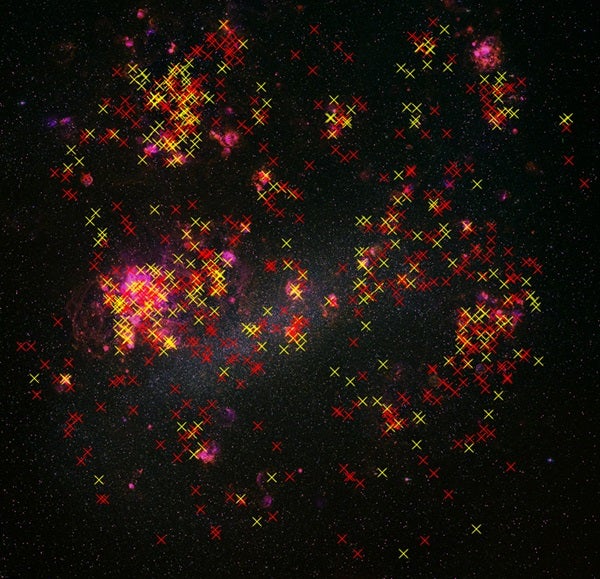Nearby red supergiant stars include such well-known suns as Betelgeuse, Antares, and Mu (μ) Cephei, and yellow supergiant stars include names like Canopus and Rho (ρ) Cassiopeiae, although these stars were not included in the study.
The group from Lowell Observatory, using NOAO facilities in Chile and the Multiple Mirror Telescope in Arizona, have observed a relatively complete set of the red and yellow supergiants in the nearby galaxies of the Large Magellanic Cloud (LMC) and M33. The astronomers compared their observations with computer models of stars derived by a group at Geneva Observatory, Switzerland, and found excellent agreement between their observed sample and theory in predicting the stellar lifetimes and general stellar properties during a critical period near the end of the stars’ lifetimes. This is in contrast to studies from three years ago by the same teams that showed large discrepancies between yellow supergiant populations and a previous version of the Geneva evolutionary models.
To astronomers, the Hertzsprung-Russell (HR) diagram (a plot of the intrinsic luminosity versus temperature of all stars) is key to understanding the evolution, or lifetime, of stars. For most of their lives, stars, fueled by hydrogen in their cores, are constant in brightness and temperature, and this phase, termed the main sequence, is well-understood. But there have been problems with understanding how the temperature and luminosity of a star rapidly changes as the core of the star is exhausted at the end of the stellar life. Understanding the late stages of stellar evolution is important for other questions, too. Yellow supergiants may be the progenitors of core-collapse supernovae, and understanding supernovae completely has important implications for cosmology.
Interpreting the HR diagram depends on mathematical models of a star’s interior, which indicate how stars of different masses change with age. These models, based on knowledge of the physics of nuclear reaction rates, predict how a star of a given mass will change in temperature and luminosity over its lifetime, but models require careful comparison with actual observations.
Suppose curious aliens visited Earth and noted that human weight and height increase with age. The aliens might propose a model for human growth in which weight and height increase smoothly with age, but this model would not allow for adolescent growth spurts or middle age. If they compared their model with further measurements of fast-sprouting teenagers, they would be puzzled. This is akin to the problem astronomers have faced in understanding the red and yellow supergiants.
Previous evolutional models predicted far too many yellow supergiants — in other words, theoretical yellow supergiants seem to live much longer than the real stars in nature. This may resonate with those familiar with star names: It’s easy to come up with examples of red supergiants like Betelgeuse, but more difficult to think of examples of yellow supergiants whose lifetimes are measured in only a few tens of thousand years.
The Lowell group studied the supergiants in nearby galaxies rather than our Milky Way to avoid the problems of identifying and characterizing stars at different distances. First, they selected stars based on their colors and angular motion across the sky. For the LMC study, they obtained spectra of almost 2,000 stars by making use of Hydra, a spectrograph on the Blanco 4-meter telescope on Cerro Tololo in northern Chile that allows many stars to be observed at the same time. They obtained a similar number of spectra of the M33 stars using Hectospec on the 6.5-meter MMT telescope located on Mt. Hopkins in southern Arizona. The spectra provide a star’s radial velocity — motion toward or away from us. This is key to deciding which stars are actually foreground red and yellow stars in our Milky Way Galaxy masquerading as red supergiants in these other galaxies.










